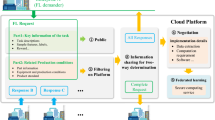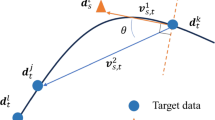Abstract
Today’s manufacturing systems are becoming increasingly complex, dynamic and connected hence continual prediction of manufactured product quality is a key to look for patterns that can eventually lead to improved accuracy and productivity. Recent developments in artificial intelligence, especially machine learning have shown great potential to transform the manufacturing domain through analytics for processing vast amounts of manufacturing data generated (Esmaeilian et al. in J Manuf Syst 39:79–100, 2016). Although prediction models have been built to predict product quality with good accuracy, they assume that same distribution applies on training data and testing data hence fail to produce satisfying results when machines work under different conditions with varying data distribution. Naïve re-collection and re-annotation of data for each new working condition can be very expensive thus is not a feasible solution. To cope with this problem, we adopt transfer learning approach called domain adaptation to transfer the knowledge learned from one labelled operating condition (source domain) to another operating condition (target domain) without labels. Particularly, we propose an end-to-end framework for cross-machine product quality prediction, which is able to alleviate domain shift problem. To facilitate the cross-machine prediction performance, a systematic feature selection approach is designed and integrated to generate most suitable feature set to characterize the collected data. Comprehensive experiments have been conducted using actual manufacturing data and the results demonstrate significant improvement on cross-machine product quality prediction as compared to conventional techniques.





Similar content being viewed by others
References
Aghdam, B., Vahdati, M., & Sadeghi, M. (2015). Vibration-based estimation of tool major flank wear in a turning process using ARMA models. The International Journal of Advanced Manufacturing Technology, 76(9–12), 1631–1642.
Breiman, L. (2001). Random forests. Machine Learning, 45(1), 5–32.
Çaydaş, U., & Ekici, S. (2012). Support vector machines models for surface roughness prediction in CNC turning of AISI 304 austenitic stainless steel. Journal of intelligent Manufacturing, 23(3), 639–650.
Chen, T., & Guestrin, C. (2016). A scalable tree boosting system. In: Proceedings of the 22nd acm sigkdd international conference on knowledge discovery and data mining, pp 785–794.
Chen, Y., Sun, R., Gao, Y., & Leopold, J. (2017). A nested-ANN prediction model for surface roughness considering the effects of cutting forces and tool vibrations. Measurement, 98, 25–34.
Chih, H. Y., Fan, Y. C., Peng, W. C., & Kuo, H. Y. (2020). Product quality prediction with convolutional encoder-decoder architecture and transfer learning. In: Proceedings of the 29th ACM International Conference on Information & Knowledge Management, pp 195–204.
Esmaeilian, B., Behdad, S., & Wang, B. (2016). The evolution and future of manufacturing: A review. Journal of Manufacturing Systems, 39, 79–100.
Grzenda, M., & Bustillo, A. (2019). Semi-supervised roughness prediction with partly unlabeled vibration data streams. Journal of Intelligent Manufacturing, 30(2), 933–945.
Guyon, I., Weston, J., Barnhill, S., & Vapnik, V. (2002). Gene selection for cancer classification using support vector machines. Machine Learning, 46(1–3), 389–422.
Hessainia, Z., Belbah, A., Yallese, M. A., Mabrouki, T., & Rigal, J. F. (2013). On the prediction of surface roughness in the hard turning based on cutting parameters and tool vibrations. Measurement, 46(5), 1671–1681.
Huang, S. W., Lin, C. T., Chen, S. P., Wu, Y. Y., Hsu, P. H., & Lai, S. H. (2018). Auggan: Cross domain adaptation with gan-based data augmentation. In: Proceedings of the European Conference on Computer Vision (ECCV), pp 718–731.
James, G., Witten, D., Hastie, T., & Tibshirani, R. (2013). An introduction to statistical learning, (Vol. 112). Springer.
Jurkovic, Z., Cukor, G., Brezocnik, M., & Brajkovic, T. (2018). A comparison of machine learning methods for cutting parameters prediction in high speed turning process. Journal of Intelligent Manufacturing, 29(8), 1683–1693.
Kano, M., & Nakagawa, Y. (2008). Data-based process monitoring, process control, and quality improvement: Recent developments and applications in steel industry. Computers and Chemical Engineering, 32(1–2), 12–24.
Karayel, D. (2009). Prediction and control of surface roughness in CNC lathe using artificial neural network. Journal of Materials Processing Technology, 209(7), 3125–3137.
Kwon, Y., Fischer, G. W., & Tseng, T. L. (2002). Fuzzy neuron adaptive modeling to predict surface roughness under process variations in CNC turning. Journal of Manufacturing Systems, 21(6), 440–450.
Li, N., Chen, Y., Kong, D., & Tan, S. (2017). Force-based tool condition monitoring for turning process using v-support vector regression. The International Journal of Advanced Manufacturing Technology, 91(1–4), 351–361.
Lin, Y. C., Chen, Y. C., Wu, K. D., & Hung, J. P. (2020). Prediction of surface roughness based on the machining conditions with the effect of machining stability. Advances in Science and Technology Research Journal, 14(2), 171–183.
Lin, W. J., Lo, S. H., Young, H. T., & Hung, C. L. (2019). Evaluation of deep learning neural networks for surface roughness prediction using vibration signal analysis. Applied Sciences, 9(7), 1462.
Lu, C., Ma, N., Chen, Z., & Costes, J. P. (2010). Pre-evaluation on surface profile in turning process based on cutting parameters. The International Journal of Advanced Manufacturing Technology, 49(5–8), 447–458.
Nada, O. A., ElMaraghy, H. A., & ElMaraghy, W. H. (2006). Quality prediction in manufacturing system design. Journal of Manufacturing Systems, 25(3), 153–171.
Pan, S. J., Tsang, I. W., Kwok, J. T., & Yang, Q. (2010). Domain adaptation via transfer component analysis. IEEE Transactions on Neural Networks, 22(2), 199–210.
Pan, S. J., & Yang, Q. (2009). A survey on transfer learning. IEEE Transactions on Knowledge and Data Engineering, 22(10), 1345–1359.
Shao, C., Paynabar, K., Kim, T. H., Jin, J. J., Hu, S. J., Spicer, J. P., et al. (2013). Feature selection for manufacturing process monitoring using cross-validation. Journal of Manufacturing Systems, 32(4), 550–555.
Shen, Y., Yang, F., Habibullah, M. S., Ahmed, J., Das, A. K., Zhou, Y., & Ho, C. L. (2020). Predicting tool wear size across multi-cutting conditions using advanced machine learning techniques. Journal of Intelligent Manufacturing, 1–14.
Sizemore, N. E., Nogueira, M. L., Greis, N. P., & Davies, M. A. (2020). Application of machine learning to the prediction of surface roughness in diamond machining. Procedia Manufacturing, 48, 1029–1040.
Sun B, Feng J, Saenko K (2017) Correlation alignment for unsupervised domain adaptation. In: Domain Adaptation in Computer Vision Applications, Springer, pp 153–171
Wang, H., Bai, X., Tan, J., & Yang, J. (2020a). Deep prototypical networks based domain adaptation for fault diagnosis. Journal of Intelligent Manufacturing, 1–11.
Wang, J., Wang, P., & Gao, R. X. (2015). Enhanced particle filter for tool wear prediction. Journal of Manufacturing Systems, 36, 35–45.
Wang, J., Zou, B., Liu, M., Li, Y., Ding, H., & Xue, K. (2020b). Milling force prediction model based on transfer learning and neural network. Journal of Intelligent Manufacturing, 1–10.
Wilson, G., & Cook, D. J. (2020). A survey of unsupervised deep domain adaptation. ACM Transactions on Intelligent Systems and Technology (TIST), 11(5), 1–46.
Zhao, K., Jiang, H., Wu, Z., & Lu, T. (2020). A novel transfer learning fault diagnosis method based on manifold embedded distribution alignment with a little labeled data. Journal of Intelligent Manufacturing, 1–15.
Author information
Authors and Affiliations
Corresponding authors
Additional information
Publisher's Note
Springer Nature remains neutral with regard to jurisdictional claims in published maps and institutional affiliations.
Rights and permissions
About this article
Cite this article
Wang, Y., Cui, W., Vuong, N.K. et al. Feature selection and domain adaptation for cross-machine product quality prediction. J Intell Manuf 34, 1573–1584 (2023). https://doi.org/10.1007/s10845-021-01875-z
Received:
Accepted:
Published:
Issue Date:
DOI: https://doi.org/10.1007/s10845-021-01875-z




